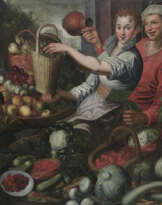ID 842461
Lot 631 | Joachim Beuckelaer
Estimate value
€ 12 000 – 18 000
Antwerp ca. 1533 - ca. 1574
Workshop
Title: Market Place.
Technique: Oil on wood.
Measurement: 96 x 117cm.
Frame: Framed.
Provenance:
Private ownership, Germany.
With a direct and challenging gaze, the market woman in the foreground turns towards the viewer. Her rolled-back sleeves characterise her as an energetic and hands-on nature who knows her surroundings intimately. "Look here", she seems to murmur to her contemporaries. To her right and left, several young maids are offering all kinds of goods for sale: the young woman on the left is selling her vegetables, bread, eggs and rabbits are on sale in front, the two girls on the right are selling chickens, the one behind them is offering smoked fish. On closer inspection, the cheerful scene turns out to be a picture full of erotic allusions. While their downward gaze feigns modesty, the gentlemen stare unabashedly into the all too revealing cleavage of the young ladies. The lecher in the middle has only one thing on his mind and is about to step blindly into a basket full of eggs. In the background, a red-faced drunkard gestures admonishingly with his whip, while his horses dutifully cart in barrels of wine that have just been embarked at the harbour. Under his pink trousers, his bulging sex is unseemly. The curved, upward-curving shape of the courgette, which stands out in bright green in the left half of the picture, arouses similar associations. It attracts the interest of the maid, whose gaze is bashfully directed at the stick-shaped vegetable. The birds in the range of goods are also conceptually connoted with the erotic sub-theme: In Dutch and German, the verb "vögeln" is synonymous with the sexual act, then as now.
Such depictions were primarily for the amusement of Amsterdam's high society. They turned up their noses in amusement at the shameless behaviour of the peasants and market people. At the same time, the artist kept the allusions so subtle that no one could claim to find lewd elements in the picture. The actual message of the picture, however, only becomes clear when we look at the background. There, carousing people are cavorting on the right side of a temple. Under the portico, a society sits at a table, writing, trading, absorbed in its business, ignoring the purpose of a place of worship as a house of prayer. Probably an incident from the New Testament is depicted here: The moment before Jesus drives the merchants out of the temple. This biblical episode was quite familiar to contemporary viewers. In the pictorial interweaving of this Gospel scene with the secular everyday scene, the artist translated the Bible story into his present. In this way, the public knew how to interpret the depiction as a moral lesson, as a warning against the sensual dangers of the world.
Originally created by Pieter Aertsen, Joachim Beuckelaer's uncle, the genre of the market painting represents an essential preliminary stage in the development of Dutch genre and still-life painting. For two generations, this spectacular new pictorial genre was one of the coveted bestsellers of noble Dutch society. Beuckelaer and his workshop catered to the persistently high demand and brought this complex as well as highly exciting form of the hidden object painting to flower.
We are grateful to Suzanne Laemers, RKD, The Hague, for her friendly assistance in cataloguing the present painting.
| Artist: | Joachim Beuckelaer (1530 - 1573) |
|---|---|
| Applied technique: | Oil |
| Auction house category: | Old Masters |
| Artist: | Joachim Beuckelaer (1530 - 1573) |
|---|---|
| Applied technique: | Oil |
| Auction house category: | Old Masters |
| Address of auction |
VAN HAM Kunstauktionen GmbH Hitzelerstr. 2 50968 Köln Germany | ||||||||||||||
|---|---|---|---|---|---|---|---|---|---|---|---|---|---|---|---|
| Preview |
| ||||||||||||||
| Phone | +49 221 92586215 | ||||||||||||||
| Fax | +49 221 92 58 62 4 | ||||||||||||||
| Buyer Premium | 32% | ||||||||||||||
| Conditions of purchase | Conditions of purchase | ||||||||||||||
| Business hours | Business hours
|










